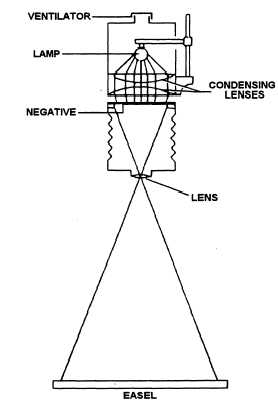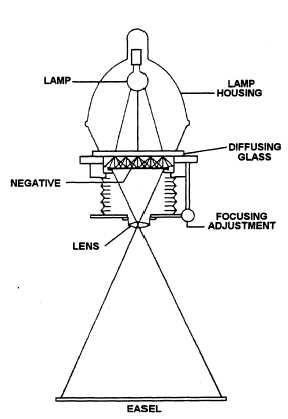Figure 11-32.—Condenser enlarger.
Figure 11-33.—Diffusion enlarger.
is ventilated to prevent excessive lamp heat from
damaging the negative. Some enlargers have blowers to
circulate air and cool the inside of the lamp housing.
The negative carrier used in an enlarger may be
either a dustless type or a glass sandwich type. The
dustless type of carrier is made of two metal plates with
an opening in the center large enough to hold the
negative. The negative is placed between these plates
and held in position by its edges. This type of carrier is
good for negatives 4 x 5 inches or smaller since these
negatives are stiff enough to remain flat. The glass
sandwich type of carrier is a holder where the negative
is placed between two sheets of glass. This type of
holder is used for larger negatives since they have a
tendency to sag in the center if they are not supported
by glass.
The lens used in an enlarger should have an angle
of field large enough to cover the negative being printed.
A lens with a focal length approximately equal to the
diagonal of the largest negative to be printed will
provide sufficient angle of field.
The bellows of an enlarger should be capable of
extending at least twice the lens focal length. This
amount of bellows extension is necessary for making
1:1 reproductions. Although it is possible to make
reductions to any desired size, the bellows on most
enlargers cannot be extended far enough to make
reductions smaller than 1:1. Smaller reductions can be
made by using a longer final-length lens, but a better
method is to use a reducing attachment. A reducing
attachment consists of a section of supplementary
bellows fitted with a longer focal-length lens.
MAKING ENLARGEMENT PRINTS
The darkroom arrangement for enlarging is
essentially the same as for contact printing. The
safelights should be appropriate for the type of paper
being printed. The size of the prints may require larger
trays and greater amounts of solution, but they should
be setup in the sink the same as for contact printing.
For good enlargements, good negatives, a clean
enlarger, clean printing filters, correct exposure and
development, and careful processing and finishing are
necessary. Although most any negative can be printed
by projection, there are a few characteristics that are
desirable. A good negative has normal density and
contrast. It must be sharp and free from such defects as
scratches, abrasions, dust, lint and fingerprints.
11-37



